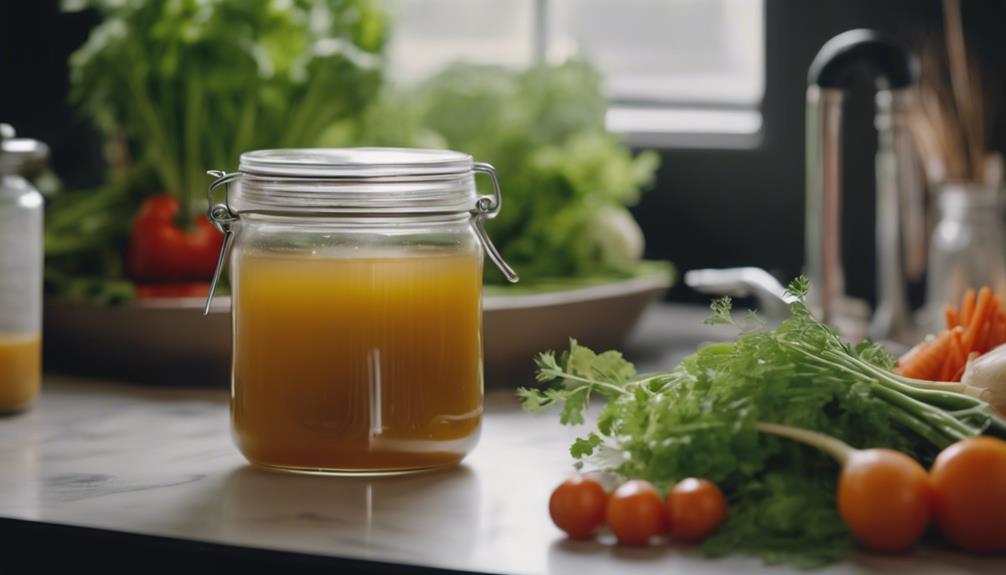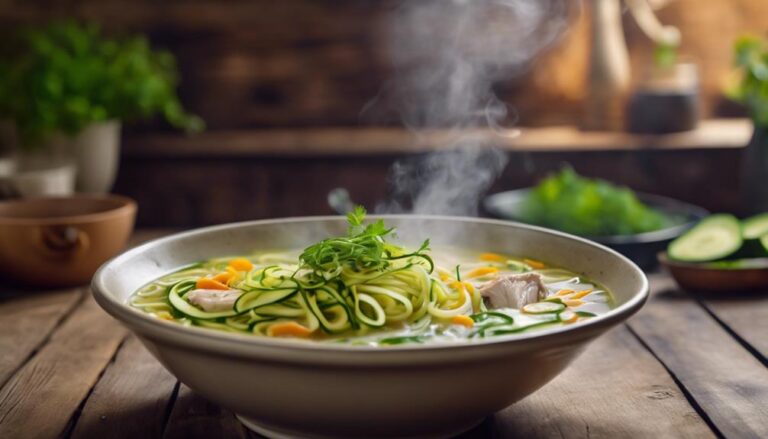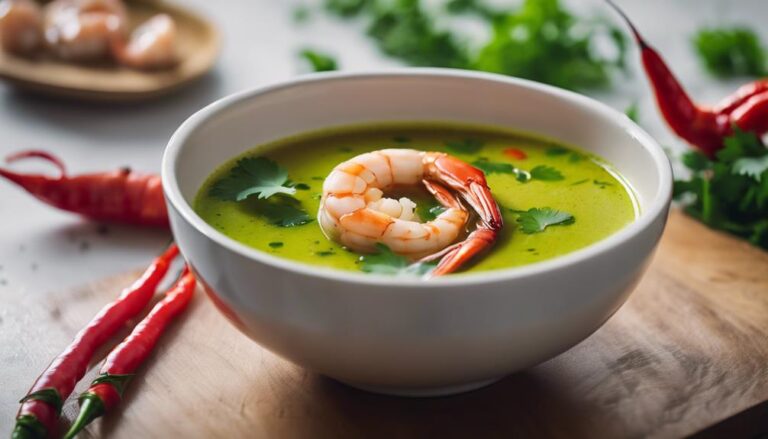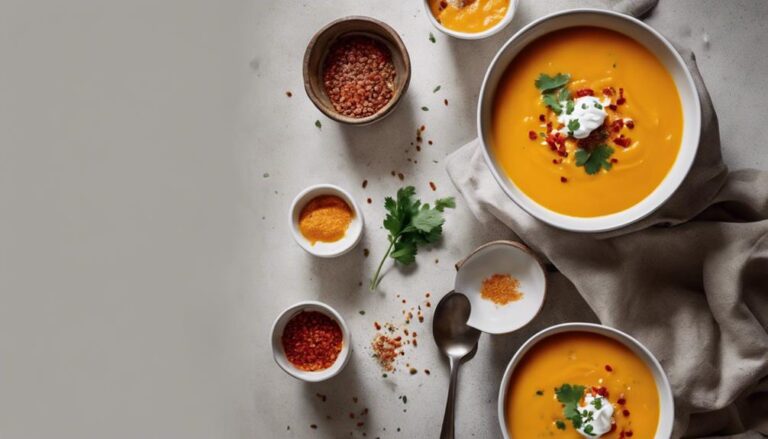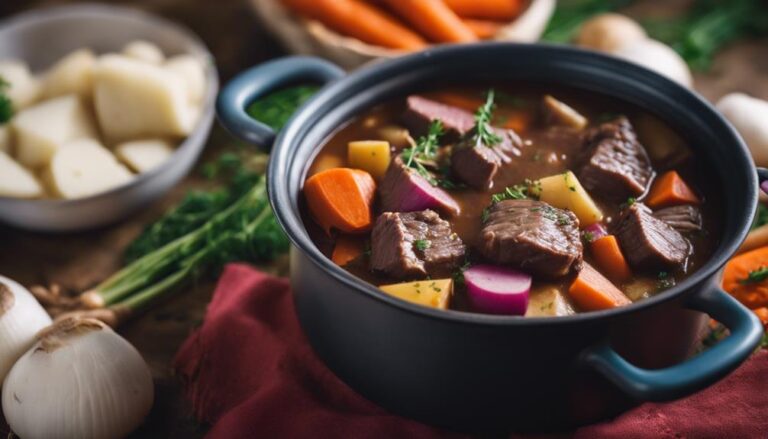Sous Vide Bone Broth: The Foundation of Paleo Cooking
Discover the essence of Paleo cuisine by utilizing sous vide for bone broth—an ancient staple reimagined. Release flavors through controlled temperatures and time, revealing nutrients important for well-being. Infuse collagen and gelatin for skin, gut, and joint health. Balance minerals like calcium and magnesium for bone strength. Enhance immunity with essential amino acids in a comforting elixir. Elevate broths with herbs, spices, and seasonal produce for a robust palette. Reveal the unparalleled depth of taste and health benefits waiting to be uncovered within each nourishing sip.
What You Will Learn Here
- Sous vide enhances flavor and clarity of bone broth.
- Maximizes collagen and gelatin extraction for health benefits.
- Customize with herbs, spices, and vegetables for unique taste.
- Precise temperature control preserves essential nutrients.
- Rich in collagen and gelatin for gut health and joint support.
Broth-Making Techniques Evolution
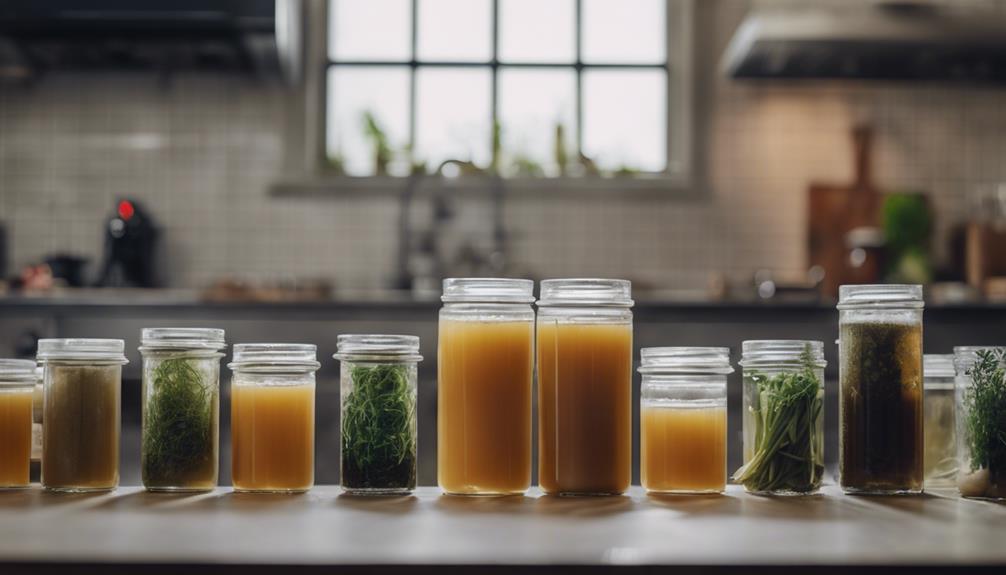
Explore the historical methods that have shaped broth-making techniques over time.
Analyze the modern innovations that have revolutionized the way broths are prepared and enjoyed today.
Examine the various flavor enhancements that have elevated the complexity and richness of broths in contemporary culinary practices.
Historical Broth Methods
Throughout history, the evolution of broth-making techniques has been marked by a series of innovative methods and practices that have shaped the foundation of culinary traditions. Traditional methods of preparing broth varied greatly across different cultures, each with its own unique cultural significance and culinary rituals. Here is a comparative analysis of historical broth-making techniques:
| Culture | Traditional Method | Cultural Significance |
|---|---|---|
| Chinese | Simmering bones with herbs for 24 hours | Symbol of health and vitality |
| French | Slow cooking bones with mirepoix | Basis of classical cuisine |
| Japanese | Combining kelp and bonito flakes | Essential umami flavor |
| Mexican | Boiling bones with chili peppers | Spicy and rich flavor profile |
| Indian | Adding turmeric and ginger | Ayurvedic healing properties |
Modern Broth Innovations
Modern broth innovations have revolutionized traditional broth-making techniques, introducing novel methods that enhance flavor profiles and nutritional benefits.
One of the most significant advancements in broth-making is the utilization of sous vide techniques. Sous vide allows for precise temperature control over long periods, resulting in broths with enhanced clarity, flavor extraction, and nutrient retention.
Research into broth health benefits has also led to the development of innovative recipes that maximize the extraction of collagen, gelatin, and other essential nutrients.
Broth Flavor Enhancements
Broth flavor enhancements in the evolution of broth-making techniques have been propelled by innovative methods such as sous vide, which offer precise control over temperature and extended durations for optimal extraction of flavors and nutrients.
To elevate your bone broth, consider seasoning options like sea salt, black pepper, and bay leaves. Umami boosters such as dried shiitake mushrooms or kombu can deepen the savory notes. Experiment with aromatic herbs like rosemary, thyme, and parsley, along with savory spices such as coriander, cumin, and ginger for added complexity.
These additions, combined with the controlled environment of sous vide cooking, ensure a rich, flavorful broth that forms the foundation for elevated Paleo cooking experiences.
Key Broth Components
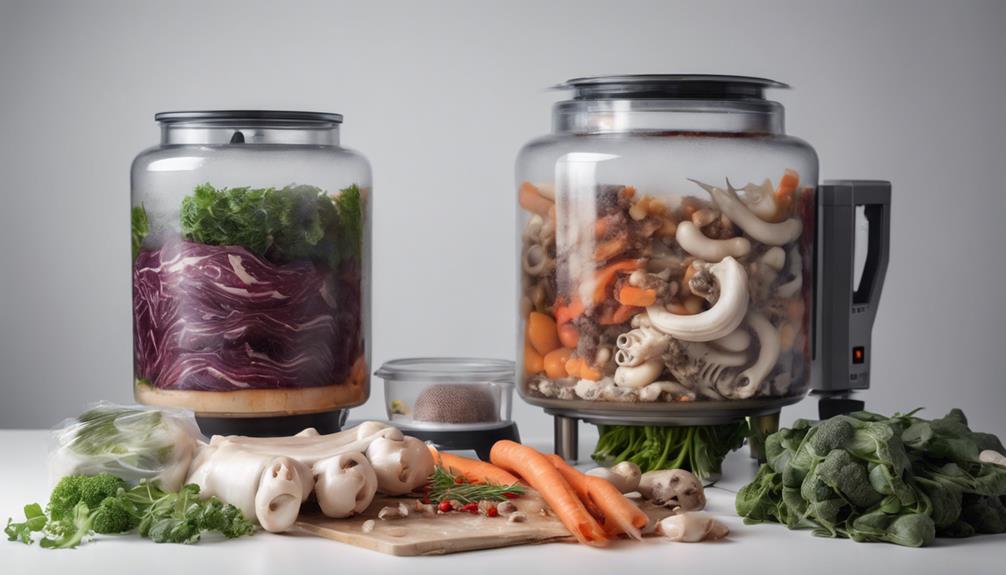
To comprehend the complete nutritional value of bone broth, it's crucial to break down its key components. When simmering bone broth, crucial nutrients are extracted from the bones and other ingredients, resulting in a rich and flavorful liquid.
Here are the key components that make bone broth a nutritional powerhouse:
- Collagen: Slow simmering bone broth helps break down collagen from connective tissues, enhancing skin elasticity and joint health.
- Gelatin: Through the slow simmering process, gelatin is released from the bones, supporting digestive health and reducing inflammation.
- Minerals: Essential minerals like calcium, magnesium, and phosphorus are extracted from the bones, aiding in bone strength and overall well-being.
- Amino Acids: Slow simmering bone broth releases amino acids such as glycine and proline, which are crucial for liver detoxification and immune function.
Broth-Based Comfort Foods
When it comes to broth-based comfort foods, you'll find a range of delicious options that aren't only satisfying but also nutrient-rich.
From a hearty beef stew recipe to a tasty chicken noodle soup, these dishes are perfect for a cozy night in.
Don't forget about the comforting warmth of a turkey and vegetable chili, each bite bursting with flavor and wholesomeness.
Hearty Beef Stew Recipe
For a hearty and satisfying meal that embodies warmth and flavor, consider diving into a well-crafted Hearty Beef Stew Recipe. Here are some key elements to elevate your stew-making experience:
- Quality Ingredients: Opt for grass-fed beef, fresh vegetables, and aromatic herbs for a significant flavor profile.
- Layered Flavors: Sear the beef before slow cooking to enhance the depth of taste in the stew.
- Essential Seasoning: Balancing salt, pepper, and herbs is essential for a harmonious blend of flavors.
- Thickening Agent: Consider using a roux or a mixture of cornstarch and water to achieve the desired consistency.
Crafting a hearty beef stew in a slow cooker is the perfect winter meal, offering comfort and nourishment in every spoonful.
Tasty Chicken Noodle Soup
Indulge in the comforting warmth and nourishing flavors of Tasty Chicken Noodle Soup, a staple in the world of broth-based comfort foods.
- Homemade Noodles: Elevate your soup game by crafting your own noodles using a simple flour, egg, and salt recipe, ensuring a fresh and hearty base for your dish.
- Flavor Profiles: Experiment with different herbs and spices like thyme, rosemary, and a hint of turmeric to create a robust flavor profile that tantalizes your taste buds.
- Broth Alternatives: Explore beyond traditional chicken broth by trying bone broth or vegetable broth for added depth and richness in your soup.
- Seasonal Vegetables: Incorporate seasonal vegetables like carrots, celery, and leeks to provide a burst of freshness and nutrients, adapting your soup to the changing seasons.
Turkey and Vegetable Chili
Turkey and Vegetable Chili delivers a hearty and nutritious meal with a robust flavor profile, perfect for those seeking a wholesome broth-based comfort dish. If you have turkey leftovers and are craving a comforting meal, this innovative chili is a perfect choice. Here's why it stands out:
- Savory Turkey: Utilizing turkey leftovers adds a rich and meaty flavor to the chili.
- Abundant Vegetables: Packed with a variety of vegetables, this chili offers a nutritional boost akin to a vegetable soup.
- Spice Blend: A carefully curated blend of spices enhances the overall taste profile, making each bite a flavorful experience.
- Broth Base: The broth forms a nourishing foundation, ensuring a satisfying and comforting meal that will warm you up from the inside out.
Broth-Enhancing Techniques
When enhancing your broth, consider flavorful infusion methods like adding herbs and aromatics during the cooking process.
Opt for time-saving simmer hacks such as using a pressure cooker or slow cooker to extract maximum flavor in minimal time.
Make nutrient-rich ingredient choices by including bones rich in collagen and vegetables packed with vitamins and minerals.
Flavorful Infusion Methods
To enhance the flavor profile of your sous vide bone broth, consider employing various infusion methods that elevate the richness and depth of the broth's taste. Aromatic spices and infusion techniques can work wonders in adding complexity to your broth.
Essential cooking plays a pivotal role in flavor development, allowing the aromas and flavors of the spices and other ingredients to meld and intensify over time. Utilize ingredients like bay leaves, peppercorns, cloves, or star anise to infuse your bone broth with enticing flavors.
Experiment with different combinations of spices to create a unique and delicious broth that will serve as a versatile base for a myriad of dishes. These infusion methods will take your bone broth to the next level of culinary excellence.
Time-Saving Simmer Hacks
Enhancing the efficiency of your bone broth preparation process involves incorporating time-saving simmer hacks that optimize the extraction of flavors and nutrients while streamlining your cooking routine.
To save time during prep, consider using a pressure cooker to speed up the simmering process considerably. This method can cut down the cooking time by more than half, allowing you to enjoy your bone broth sooner.
Additionally, using smaller bones or pre-cut bone pieces can reduce the simmering time while still extracting the essential nutrients and flavors efficiently.
Another trick is to start with hot water instead of cold, as this can help accelerate the extraction process.
Implementing these time-saving techniques can revolutionize your bone broth preparation, making it quicker and more convenient without compromising on taste or nutritional benefits.
Nutrient-Rich Ingredient Choices
Consider carefully selecting nutrient-rich ingredients to enhance the flavor profile and nutritional content of your bone broth. By choosing ingredients that support bone health and improve nutrient absorption, you can elevate the benefits of your broth. Ingredients that promote gut health and provide collagen benefits are especially valuable additions. Here is a table showcasing some nutrient-dense options for your sous vide bone broth:
| Nutrient-Rich Ingredients | Benefits |
|---|---|
| Grass-Fed Beef Bones | Rich in collagen |
| Organic Chicken Carcass | Supports gut health |
| Wild-Caught Fish Bones | Enhances nutrient absorption |
| Organic Vegetables | Provides essential vitamins |
| Seaweed | Boosts bone health |
Choosing these ingredients can transform your bone broth into a powerhouse of nutrients, promoting overall wellness and vitality.
Final Thoughts
In closing, reflect on the techniques and tips discussed throughout this article to further enhance your sous vide bone broth cooking skills. By utilizing the sous vide method, you harness the benefits of precise temperature control, allowing for a consistent extraction of flavors and nutrients from your ingredients. This approach not only boosts the taste of your bone broth but also guarantees that the essential nutrients are preserved, aligning perfectly with the nutrient-rich principles of the Paleo lifestyle.
Consider experimenting with different herbs, spices, and vegetables to customize the flavor profile of your bone broth. The sous vide technique enables these ingredients to infuse slowly and evenly, resulting in a rich and well-balanced broth that complements a variety of dishes within the Paleo diet. Additionally, the controlled cooking environment helps to retain collagen and gelatin, which are beneficial for gut health and joint support, further enhancing the health benefits of your bone broth.
Frequently Asked Questions
Can Bone Broth Be Made Using a Slow Cooker Instead of a Sous Vide Machine?
Yes, bone broth can be made using a slow cooker instead of a sous vide machine. Slow cookers offer convenience and are more budget-friendly. While sous vide provides precise temperature control, slow cookers still yield flavorful broth using longer cooking times and lower temperatures.
Are There Any Specific Types of Bones That Should Be Avoided When Making Bone Broth?
When preparing bone broth, maintain bone quality by avoiding bones with a strong gamey flavor. Opt for beef or chicken bones over game meats. Steer clear of bones with high fat content for a cleaner taste and better health benefits.
How Long Can Bone Broth Be Stored in the Refrigerator Before It Goes Bad?
In the refrigerator, bone broth typically maintains good quality for up to 4-5 days. Beyond this shelf life, spoilage can occur due to bacterial growth. Proper storage in airtight containers helps extend the freshness.
Are There Any Vegetarian Substitutes for Bone Broth That Can Be Used in Paleo Cooking?
When exploring vegetarian alternatives for bone broth in paleo cooking, you can experiment with flavorful substitutes like mushroom broth or vegetable broth. These options offer unique umami-rich profiles that can elevate your dishes.
Can Bone Broth Be Frozen for Long-Term Storage?
Yes, bone broth can be frozen for long-term storage. Freezing benefits include preserving nutrients and extending shelf life. It's a convenient way to have bone broth readily available for use in various recipes.
Conclusion
To sum up, sous vide bone broth serves as the cornerstone of paleo cooking by providing a nutrient-dense and flavorful base for a variety of dishes. By utilizing modern cooking techniques and carefully selected ingredients, this broth offers a rich and comforting element to any meal.
Incorporating broth-enhancing techniques can further elevate the taste and nutritional value of your dishes. Embrace the tradition of broth-making and elevate your paleo cooking experience with the power of sous vide bone broth.
